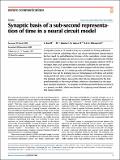Synaptic basis of a sub-second representation of time in a neural circuit model
Author(s)
Barri, A; Wiechert, MT; Jazayeri, M; DiGregorio, DA
DownloadPublished version (2.230Mb)
Publisher with Creative Commons License
Publisher with Creative Commons License
Creative Commons Attribution
Terms of use
Metadata
Show full item recordAbstract
<jats:title>Abstract</jats:title><jats:p>Temporal sequences of neural activity are essential for driving well-timed behaviors, but the underlying cellular and circuit mechanisms remain elusive. We leveraged the well-defined architecture of the cerebellum, a brain region known to support temporally precise actions, to explore theoretically whether the experimentally observed diversity of short-term synaptic plasticity (STP) at the input layer could generate neural dynamics sufficient for sub-second temporal learning. A cerebellar circuit model equipped with dynamic synapses produced a diverse set of transient granule cell firing patterns that provided a temporal basis set for learning precisely timed pauses in Purkinje cell activity during simulated delay eyelid conditioning and Bayesian interval estimation. The learning performance across time intervals was influenced by the temporal bandwidth of the temporal basis, which was determined by the input layer synaptic properties. The ubiquity of STP throughout the brain positions it as a general, tunable cellular mechanism for sculpting neural dynamics and fine-tuning behavior.</jats:p>
Date issued
2022-12-22Department
Massachusetts Institute of Technology. Department of Brain and Cognitive SciencesJournal
Nature Communications
Publisher
Springer Science and Business Media LLC
Citation
Barri, A, Wiechert, MT, Jazayeri, M and DiGregorio, DA. 2022. "Synaptic basis of a sub-second representation of time in a neural circuit model." Nature Communications, 13 (1).
Version: Final published version